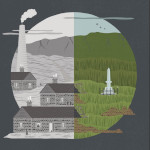Primarily recognised as session musician, and former member of the Paul McKenna Band, Seán’s ambition to launch a solo career was first fully harnessed when he was commissioned to write and perform a suite of self-penned work for the New Voices concert series at the Celtic Connections 2017 festival held in Glasgow called “The Hammering Tongue”. Throughout his writing for this new body of work Seán collaborated with Scots poet Rab Wilson who has a shared passion for Ayrshire’s mining history.
The Great Stariski is a follow-on from this creative partnership and sees Seán adapt Rab’s poem ‘The Great Stariski’, inspired by a famous Ayrshire mining story, to create a powerfully moving debut single that is underpinned by Seán’s rich Scots vocals and intricate guitar playing.

On this debut track, Seán’s vocals document the incredible story of Johnny Stariski, a miner with Polish origins, who worked at the Barony Colliery for much of his working life. Rab worked alongside Johnny in the mid-late 70s and early 80s. Johnny’s father and grandparents emigrated to Scotland just before the First World War. Johnny was born in Scotland in 1928 and went on to marry a local Ochiltree girl.
A champion high board diver and bodybuilder, Johnny famously performed a handstand on the top girder of the Barony Colliery “A” frame. This is the massive steel structure that is now preserved as an important piece of Scotland’s industrial heritage, and which still commands the landscape at the site of the Barony Colliery. The “A” Frame holds the ‘Horrals’, the mighty wheels over which the winding ropes would be spun by the winding engines to raise and lower the miners almost 2,000 feet to and from their place of work.
With The Great Stariski beginning and ending with the echoing sounds of the pit’s winding engine, Seán Gray’s vocals, acoustic guitar, electric guitar and wooden flute are accompanied by Joe Rattray (Admiral Fallow) on bass guitar and Stuart Brown (Blue Rose Code) on drums.
Speaking of the inspiration his heritage gives him, Seán said: “The story of Johnny Stariski is legend where I come from and Rab’s fantastic poem captures the incredible feat beautifully so I really wanted to pay homage to the great endeavour and to Rab’s fantastic words with this debut release. Most of the poems I have used in my music are on the subject of Ayrshire mining and are all written in Lallans Scots. My Ayrshire upbringing is an incredibly important part of who I am as a person. I grew up in the village of Coylton speaking Lallans Scots and I have a long history of coal mining in my family. I also served an apprenticeship as a mechanical engineer in a 100-year-old manufacturing factory that created equipment for mines, so the story and poem really spoke to me and I hope it will resonate with others too.”

Ghaists (Scots spelling of Ghosts) is the second single and sees Seán adapt Rab’s poem of the same name, inspired by the once thriving Ayrshire mining village of Benwhat that has been left derelict since 1952. Seán said: “When I first contacted Rab, he sent me a huge amount of his poems mainly on the subject Ayrshire coal mining and I was immediately drawn to Ghaists. I think it is of great importance that the people who worked and lived in villages such as Benwhat are remembered. The song strikes a nostalgic tone, paying tribute to an almost forgotten way of life and I hope are people are transported there when they listen to the track."
Seán plays guitar, flute and whistle on the track, as well as performing the vocals. Stuart Brown (Blue Rose Code, MNDMTH, Herschel 36) also features on drums, Craig McMahon (Fat-Suit) plays trombone and Joe Rattray (Admiral Fallow) plays bass guitar.
Rab Wilson said: “My poem Ghaists is a meditation on the ruined mining village of Benwhat, that has been derelict since 1952 and sits on a hillside between the villages of Dalmellington and Patna in East Ayrshire. In 1882 Benwhat's population was around 800 people – there's not much to see now of what was once a thriving community of miners and their families who occupied this lonely hamlet that consisted of four rows of cottages, a school and a general store. Only the outline of houses now remains, bricks overgrown with moss, to tell the story of its people.”
A sought-after guitarist, flute player and singer, Seán has spent most of the past decade playing with the award-winning Paul McKenna Band who were cited by New York Times as “The best folk band to have come out of Scotland in the last twenty years”. Also an in-demand music teacher and session musician, Seán has played with a variety of high-profile acts across the world including The Outside Track, Shane Cook, Caroline Keane & Tom Delany and The Treacherous Orchestra, to name but a few.
The Scottish language was recently added to Spotify’s list of recognised languages after a sustained campaign and Seán is proud to showcase his native tongue in his work.
Photo Credits:
(1)-(3) Seán Gray
(unknown/website).